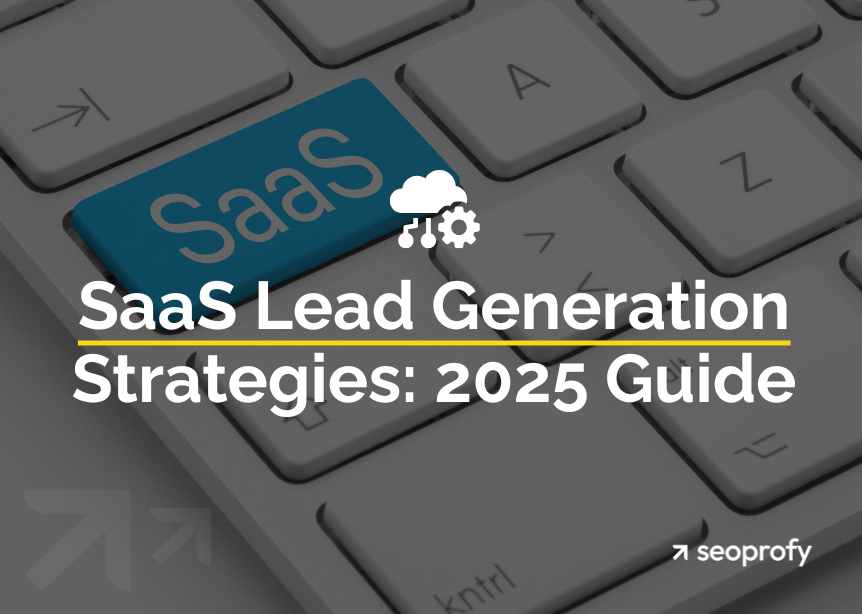Wondering whether your search engine optimization efforts are actually paying off? The answer lies in understanding the SEO Return on Investment (ROI). Calculating ROI is crucial to determining how much value your website is gaining from all the optimization measures. Knowing how to measure the ROI of SEO helps you figure out if you’re getting more than what you’ve invested—or if it’s time to rethink your strategy.
What does this calculation entail? It involves tracking your organic traffic, conversions, and, ultimately, the revenue that comes from it. By doing this, you’ll get a clear view of whether your strategy is bringing in the results you need.
SEO takes time, and getting a return from your efforts takes even longer. But when done right, it can be substantial, turning your traffic into real business growth and letting you earn passively with as few updates as needed.
Ready to understand the impact? We’ll walk you through how to measure the ROI of SEO step-by-step. Plus, we’ll dive into three real-world examples to show how this calculation looks across different business models.
What Is SEO ROI?
SEO ROI refers to the financial return a business receives from its investment in search engine optimization activities; a measure of how much value investing in strategies that boost search rankings adds to your business in terms of increased traffic, conversions, and revenue, compared to how much you’re spending.
So, how to measure SEO ROI? In most cases, it is calculated as a percentage using the following formula:
ROI = (Revenue – Cost) / Cost x 100
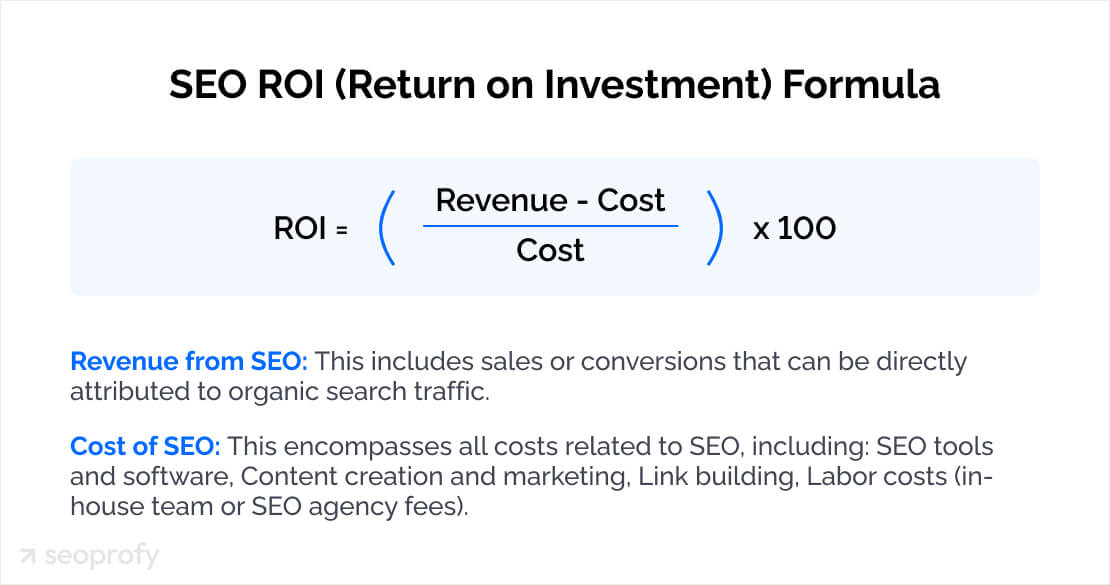
The standard SEO ROI formula shows how much your optimization efforts generate. For example, if the cost of SEO is $10,000 per month and generates $50,000 in revenue, the return would be 400%. This means for every dollar you spend on SEO, you’re earning $4 in return.
And for the big picture? Keep in mind that eCommerce search engine optimization is reported to yield a 1,600% ROI compared to paid search, giving it a clear edge in cost-effectiveness.
Why Measure SEO ROI?
Measuring SEO investment returns is not just finding out if you made money that day; crucial for any business that wants to understand the true impact of its SEO initiatives on the marketing funnel.
Every SEO program requires resources, and tracking your SEO investments can help determine if these resources and time spent are yielding the desired business outcomes. Knowing where your SEO costs are going can also help you decide if your SEO budget needs adjusting.
- Tracking SEO performance: You can assess the effectiveness of your efforts when you use indicators. Are they generating the desired results in terms of traffic and revenue? Understanding the return allows you to evaluate performance accurately.
- Justifying the investment: It’s no surprise that both stakeholders and executives are hard to please. Any SEO campaign demands financial justification. Demonstrating a good SEO ROI proves that it is not only worthwhile but also a must for business growth.
- Allocating resources: Knowing your SEO ROI allows you to make informed decisions about how to allocate resources. Whether you’re deciding how much to spend on content creation, link building, or technical search engine optimization, tracking SEO helps you optimize your budget for maximum impact.
- Improving SEO strategy: Calculating SEO ROI helps you pinpoint areas of your strategy that are working well and others that need improvement. Certain tactics may need adjusting, particularly when Google changes over 60% of meta titles and descriptions regularly, which can shift rankings and CTR. If certain strategies are not delivering high organic search results, you can adjust your approach and focus on more effective strategies.
SEO ROI statistics can give you a better perspective on how different industries perform in terms of organic traffic returns. And if you are running search engine optimization for a large company, tracking enterprise SEO ROI is a must to see how each resource pulls its weight across different areas.
How to Measure SEO ROI?
In SEO campaigns, tracking ROI SEO involves assessing total costs across all SEO activities. This includes everything from content creation to using analytics software that provides insights into your SEO progress. As we have mentioned, important SEO performance indicators include organic traffic growth, conversion rates, and customer lifetime value. Here are the ways you’ll measure them:
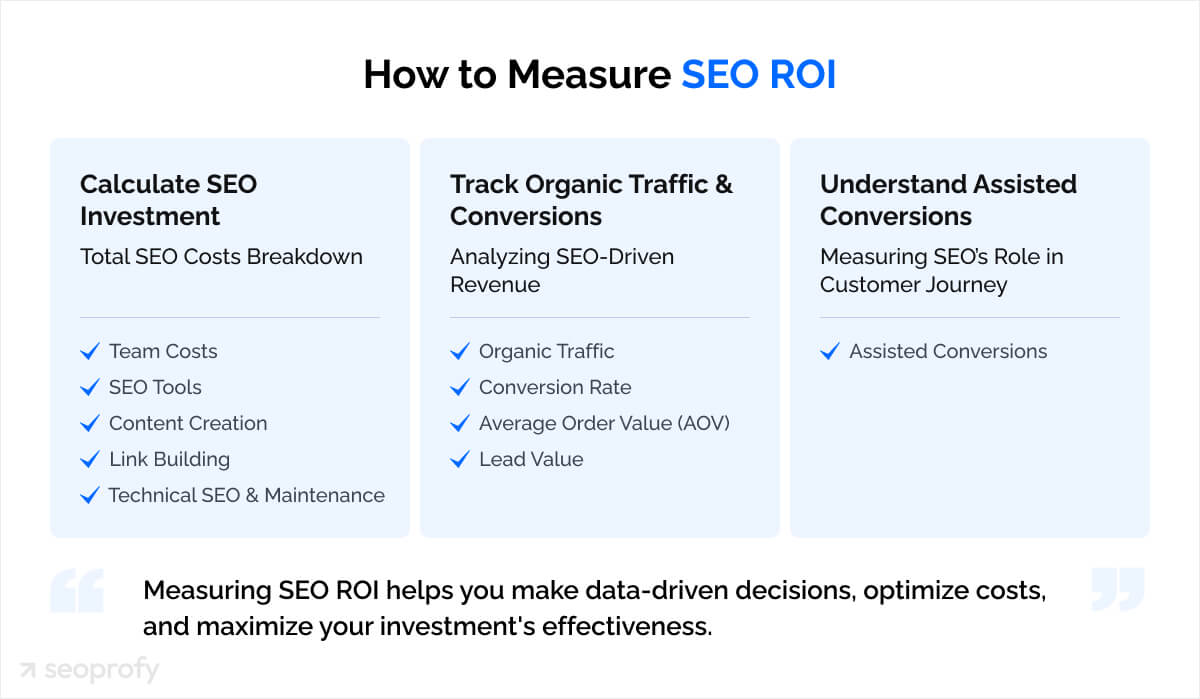
1. Calculate SEO Investment
The first step is calculating your total SEO investment. This includes all costs related to your efforts. The key components are team costs, SEO tools, content creation, link building, and technical SEO. To put things in perspective, about 57% of B2B marketers report search engine optimization as their most effective digital initiative, understanding these costs is essential to ensure a high return on investment.
Let’s have a quick look at each one and why they matter when you want to calculate ROI of SEO for any campaign:
Team Сosts
Whether you have an in-house team or you plan on outsourcing SEO campaigns to pros, the costs associated with your team should be included. This includes salaries, benefits, and contractor fees.
For businesses working with an SEO agency, typical costs can include monthly retainers or project-based fees, which are significant—SEO agencies in the U.S. charge an average of $2,501 to $5,000 per project.
Using Tools
Beyond Google Analytics, advanced tools like Ahrefs, SEMrush, Moz, and Screaming Frog can help with target keyword research, tracking performance, and analyzing backlinks. These tools provide valuable insights that support and enhance your SEO strategy but come with substantial investments.
Content Creation
Search engine optimization thrives on high-quality, optimized content. In fact, businesses report 44% of their traffic coming from search engines on small blogs, with larger blogs seeing up to 89%. This highlights the importance of investing in content that attracts and engages organic visitors.
The cost of SEO in content creation includes the expenses for blog writers, editors, and designers who produce content that ranks in search engines. It is important to forecast your ROI. This allows you to set realistic goals based on the expected impact of this investment.
Link Building
Backlinks from reputable websites can significantly improve your search engine rankings. Whether you’re engaging in manual outreach for guest posts, using a link-building service, or running influencer marketing campaigns, the cost of building quality backlinks should be included in your search engine optimization expenses to evaluate the ROI of SEO correctly.
Technical SEO and Website Maintenance
Ensuring your site is mobile-friendly, optimizing page speed, and fixing crawl errors are all essential parts of technical SEO. These costs, along with ongoing website maintenance and hosting, should be tracked to provide a comprehensive view of your SEO investment.
SEO ROI calculator tools can be used to simplify this process by crunching the numbers for you, giving you a real-time overview of your return on investment.
2. Track Organic Traffic Conversions
Once you’ve calculated your total SEO investment, the next step is to track how much revenue your efforts are generating. Start by examining how much organic traffic your site is attracting, then measure conversions from this traffic. Organic traffic refers to visitors who land on your site through search engines without clicking on paid ads.
Improving SEO ROI involves understanding which keywords bring in this valuable traffic, allowing you to better align your strategy with customer search behaviors.
Conversion Rate
The percentage of visitors who take a desired action—whether it’s making a purchase, filling out a contact form, or subscribing to your newsletter. For eCommerce websites, this would be the number of transactions, while for lead-generation sites, it could be the number of contact form submissions.
Tracking and improving conversion rates is essential, as search-engine leads tend to yield higher close rates, with an average of 14.6% compared to only 1.7% for outbound leads. By focusing on high-converting pages and making them more engaging, you can improve ROI through SEO and capture additional leads.
Average Order Value (AOV)
For eCommerce sites, tracking the average amount of money your target audience spends per transaction is crucial for calculating the revenue generated from organic search traffic. You can calculate this by dividing the total revenue by the number of transactions.
Lead Value
For businesses that don’t generate direct sales from their website, such as service-based companies, you’ll need to assign dollar values to each lead.
Use Google Analytics to track organic traffic and conversions and pair it with an SEO ROI dashboard to track real-time performance metrics to make data-driven decisions
3. Understand Assisted Conversions
Assisted conversions involve multiple touchpoints before the user completes a desired action, such as making a purchase or filling out a form. Search engine optimization often plays a supporting role in the conversion process, even if the final conversion is attributed to other marketing channels (e.g., paid search or social media).
Let’s say a customer found your website at the top of the search engine results pages through an organic search, then later returned through a retargeting ad and made a purchase. In this case, search engine optimization still played a critical role in driving the initial interest, and how much revenue SEO contributes here should be factored into your ROI calculations.
Use Google Analytics to track assisted conversions and understand how search engine optimization contributes to the overall customer journey.
SEO Metrics to Monitor for ROI
What does it mean to forecast SEO ROI? It’s a good place to start, giving you a rough idea of what to expect. But if you’re after real insights—the kind that show you what’s actually happening with your efforts—you need to measure. That’s where the magic lies. With consistent tracking, you get more than a prediction; you see concrete results.
Businesses often use analytics software to track organic growth and conversions, ensuring their SEO tasks are contributing to the bottom line. Keeping track of these metrics allows you to justify ROI SEO to stakeholders, especially when marketing budgets are at stake. By keeping tabs on conversions, organic traffic, and customer lifetime value, you’re equipped to make adjustments that hit closer to the mark.
1. Conversions and Leads
One of the most direct ways of measuring SEO success is by tracking conversions and leads from organic traffic. This can include purchases, form submissions, or any other actions that contribute to your business goals. Measuring how many leads turn into sales directly impacts the overall ROI SEO and informs future optimization strategies.
However, measuring ROI can vary drastically across various industries. As we have mentioned earlier, for lead-generation businesses, tracking the number of leads generated from organic traffic is key, while for eCommerce, tracking sales through an eCommerce report is the main focus.
- Set up conversion tracking: Use Google Analytics or your CRM to track leads.
- Monitor conversion rates: How many visitors are taking action?
- Analyze key actions: Whether it’s purchases or sign-ups, keep tabs on what drives value. Assign dollar values for online transactions.
- Adjust based on data: Are certain pages or your long-tail SEO campaigns underperforming? Make data-driven moves to improve search visibility.
2. Organic Traffic
Organic search traffic is like oxygen, the very thing that keeps your brand alive and relevant. However, it’s not just about the quantity of traffic; it’s about the quality. You need to ensure that the traffic you’re attracting is relevant and converting into customers. Monitoring your overall organic traffic growth is essential, but pairing this with conversion tracking gives you a clearer picture of ROI.
- Check overall organic traffic: Keep tabs on total organic search traffic coming in.
- Focus on traffic quality: Is it relevant, or are people bouncing?
- Track conversion alongside traffic: Traffic doesn’t mean much without conversions.
- Analyze behavior patterns: Where are they coming from, and how are they interacting?
3. Customer Lifetime Value (LTV)
Customer lifetime value is an essential metric for businesses that rely on repeat customers. LTV measures the total revenue a business expects to generate from a customer over their entire relationship with the company. Increasing the number of high-LTV customers dramatically improves your ROI.
- Identify high-LTV customers: Who brings the most value over time?
- Use SEO to target similar profiles: Aim to attract more of the same clients.
- Track long-term relationships: What efforts contribute to retaining customers?
- Focus on customer engagement: Keep those repeat customers coming through tailored content.
If certain tactics are not delivering results, you can adjust your approach and focus on more effective strategies. For a clearer picture, statistics provide month-over-month data, letting you track which efforts are actually giving your investment a lift.
Challenges of Calculating SEO ROI
One of the challenges in any SEO campaign is accurately attributing conversions. What’s a good ROI for SEO? Typically, anything above 5x indicates a healthy ROI, showing your efforts are paying off, and justifying SEO costs. The thing is, calculating the average ROI for SEO isn’t always so simple and easy. Here are some common challenges you may encounter:
1. Time Lag in Results
One of the challenges with ROI SEO tracking is the length of time needed to see results. As we all know, search engine optimization is a long-term investment, and it can take several months to actually say “Hey, our strategy worked,” especially for new websites or highly competitive industries. This time lag can make it difficult to measure the immediate positive ROI.
2. Attribution Issues
Attribution refers to assigning the right value to all marketing channels that contribute to the conversion. Search engine optimization often plays a role in a customer’s journey but may not be credited with the final conversion. Understanding assisted conversions and multi-touch attribution models is essential for accurate measurement.
3. Branded vs Non-Branded Traffic
Distinguishing between branded and non-branded traffic is another challenge.
- Branded traffic comes from users who search for your business name directly.
- Non-branded traffic comes from users searching for more general industry-related keywords.
Non-branded traffic is often more valuable because it indicates that your efforts are attracting new potential customers, rather than just repeat visitors.
How to Calculate SEO ROI: 3 Examples
Understanding your SEO ROI is essential because it shows how your content strategies, marketing efforts, and analytics tracking contribute to your business’s growth. But how do you transform this data into actionable numbers? Let’s explore three examples of business models to see how ROI can be calculated in each.
Case #1: Ecommerce – Jewelry Store
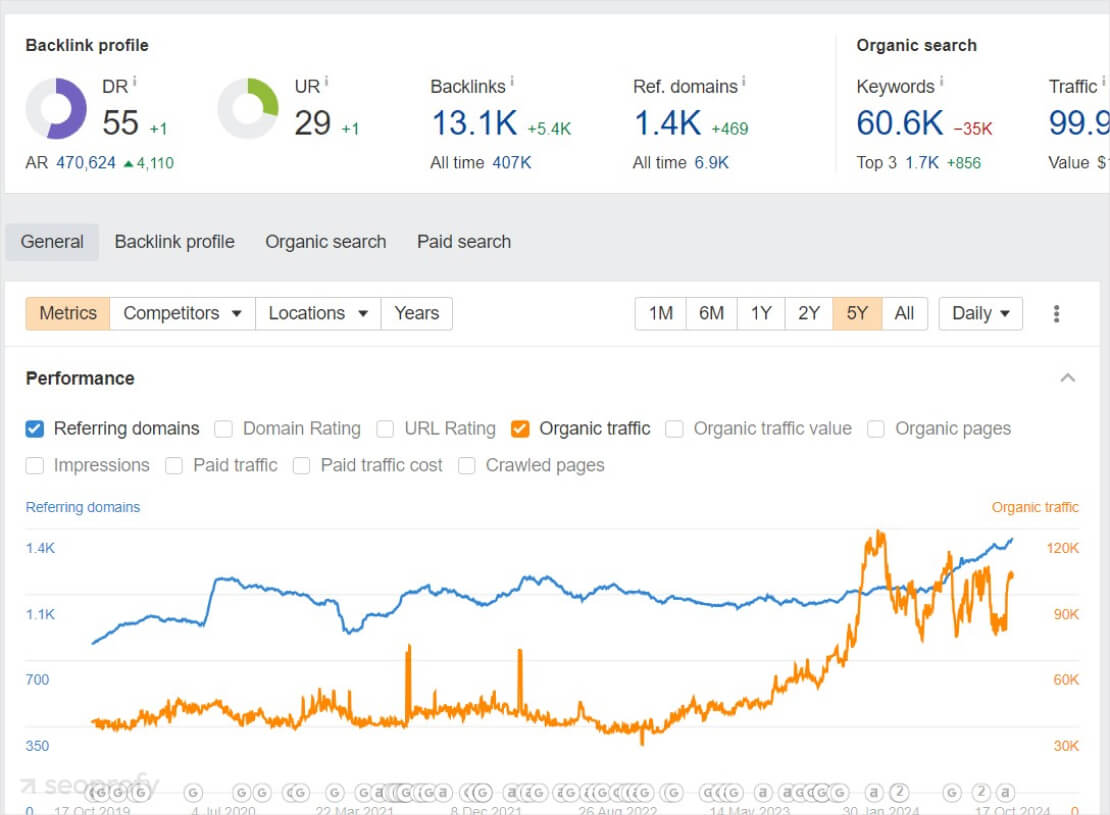
For ecommerce stores, search engine optimization can make the difference between continuing the business or filing for bankruptcy. Let’s say a jewelry store invests $480,000 over five years, focusing on building quality backlinks, optimizing product pages, and creating content. During this period, the site attracts 1,258,000 total visitors, with a 2% conversion rate. The average order value is $100.
How do you calculate SEO ROI?
Revenue:
- Total visitors over 5 years: 1,258,000.
- Total sales over 5 years: 1,258,000 total visitors×2%=25,160.
- Total revenue over 5 years: 25,160 sales×$100 AOV=$2,516,000.
Total investment over 5 years: $480,000.
SEO ROI = ($2,516,000−$480,000)/$480,000×100%=424.17%
What’s the ROI from SEO Investment? For every $1 spent on eCommerce SEO, the jewelry store is making $42,17 in return. A 424.17% ROI is an outstanding return and shows the immense value of a well-executed SEO strategy for an eCommerce business.
By implementing the right SEO tactics, this eCommerce store attracted a significant number of visitors, leading to more eCommerce purchases and conversions. This case highlights how SEO efforts translate into real revenue.
Case #2: SaaS – HR Software
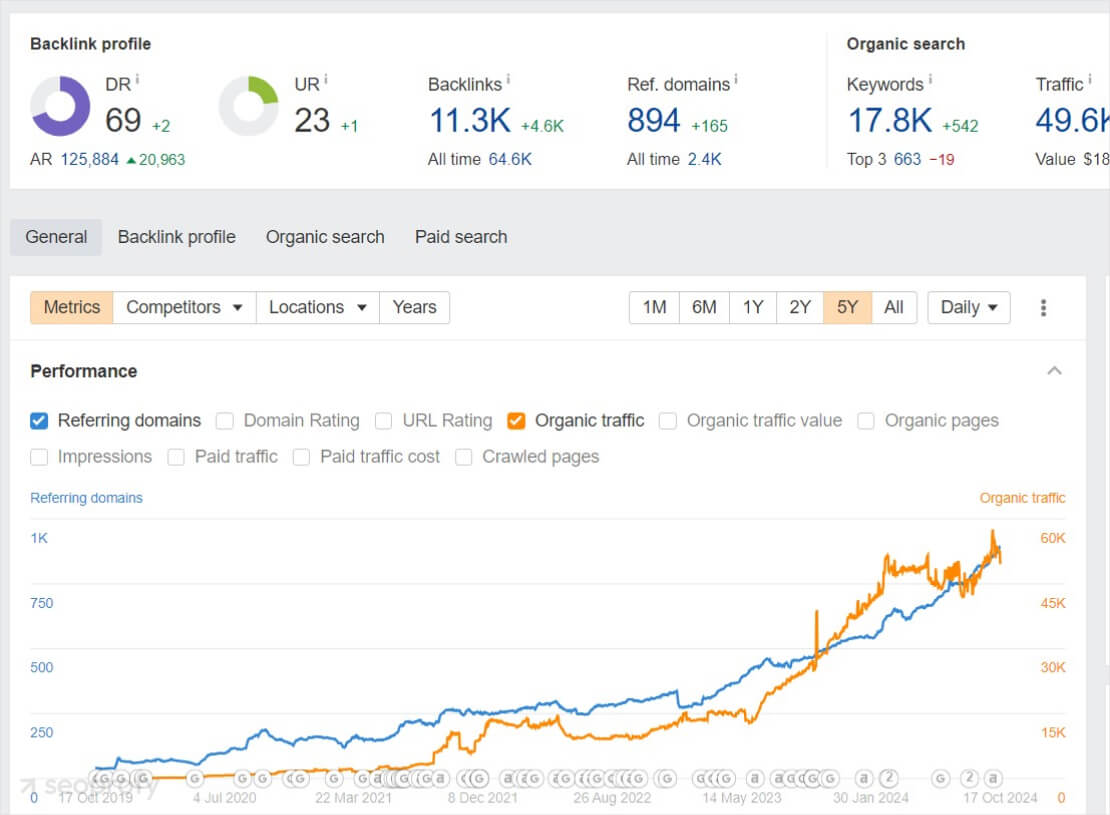
For those in the SaaS industry, it’s always easier to work with a SaaS SEO agency that can help streamline strategy, boosting monthly organic traffic and customer acquisition specifically for subscription-based models.
Let’s assume a company invests $672,000 in SEO over five years, focusing on ranking for long-tail keywords related to HR software and acquiring high-quality backlinks. During this period, the site attracts 1,031,673 total visitors, with a 1.5% conversion rate and an average LTV of $900 per customer.
To calculate SEO ROI:
Revenue
- Total visitors over 5 years: 1,031,673.
- Total subscriptions over 5 years: 1,031,673 total visitors×1.5%=15,475.
- Total revenue over 5 years: 15,475 subscriptions×$900 LTV=$13,927,500
Total investment over 5 years: $672,000
SEO ROI = ($13,927,500 -$672,000)/$672,000×100%=1972.7%
This SaaS company sees a substantial return on its investment, highlighting the importance of optimization for subscription-based models with high LTV.
Case #3: Home Services – Moving Company in New York
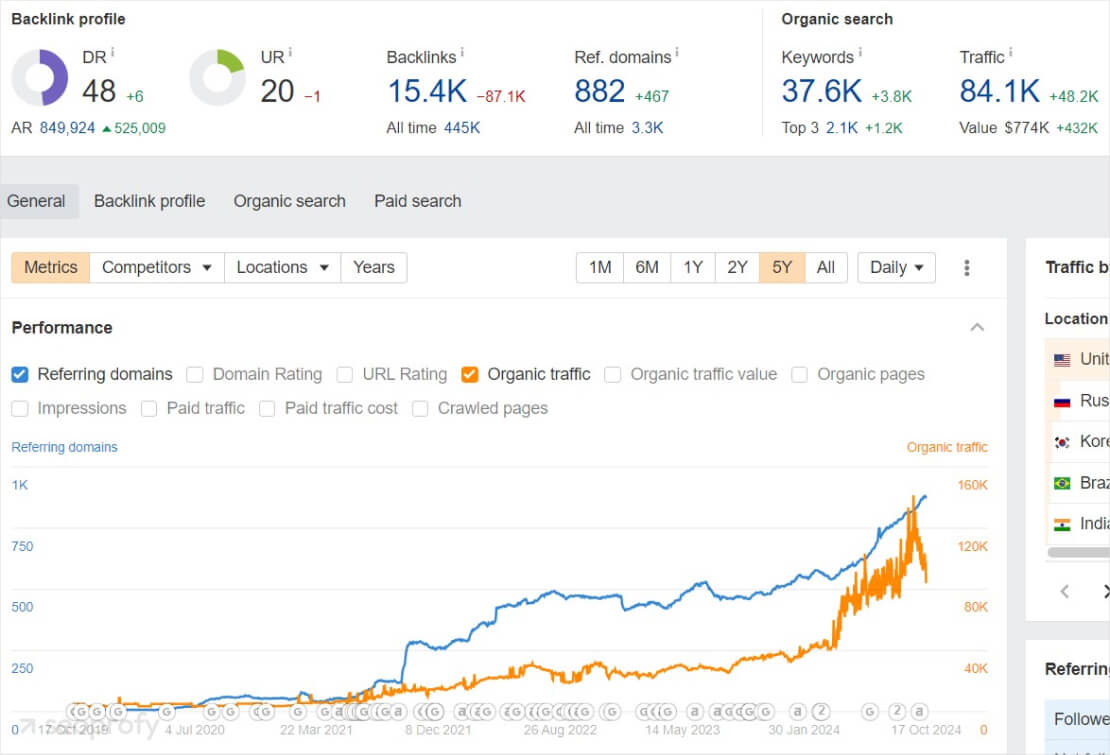
Now, consider a moving company in New York. Let’s say it invests $4,000 per month in SEO services for moving companies over five years to rank for local organic search queries like “moving company NYC” and to build local citations. During this period, the site attracts 1,820,000 organic visitors, with a 5% conversion rate for quote requests. Out of these requests, 25% convert into paying customers, with an average moving service cost of $350.
Revenue:
- Total visitors over 5 years: 1,820,000.
- Quote requests over 5 years: 1,820,000 total visitors×5%=91,000.
- Organic conversions over 5 years: 91,000 quote requests×25%=22,750 paying customers.
- Total revenue over 5 years: 22,750 paying customers×$350 (average service cost)=$7,962,500
Total investment over 5 years: $240,000
To calculate SEO return on investment, add up your total costs and measure them against the revenue from organic traffic:
SEO ROI = ($7,962,500−$240,000)/$240,000×100%=3217,71%
For a local business like a moving company, a 3217,71% ROI is a remarkable indicator that SEO is an extremely high-value marketing channel. They are making $321,77 for every $1 spent, proving that local SEO can be extraordinarily lucrative for service-based businesses.
Improve Your SEO ROI with SeoProfy
Maximizing your returns doesn’t have to be a guessing game. By partnering with an experienced SEO agency, you can ensure that every dollar spent generates tangible returns for your business.
A professional service will help you build high-quality backlinks, optimize your content for target keywords, and track performance, and organic impressions using advanced tools and techniques.
Whether you’re in eCommerce, SaaS, or offering local services, investing in professional services can significantly improve your SEO performance and increase your positive ROI. With a well-crafted strategy and ongoing optimization, you can see long-term growth in traffic, leads, and revenue.
Ready to take your content strategy to the next level? Reach out to SeoProfy today. Our professional, white-hat services will help you maximize your returns and drive real business growth.










